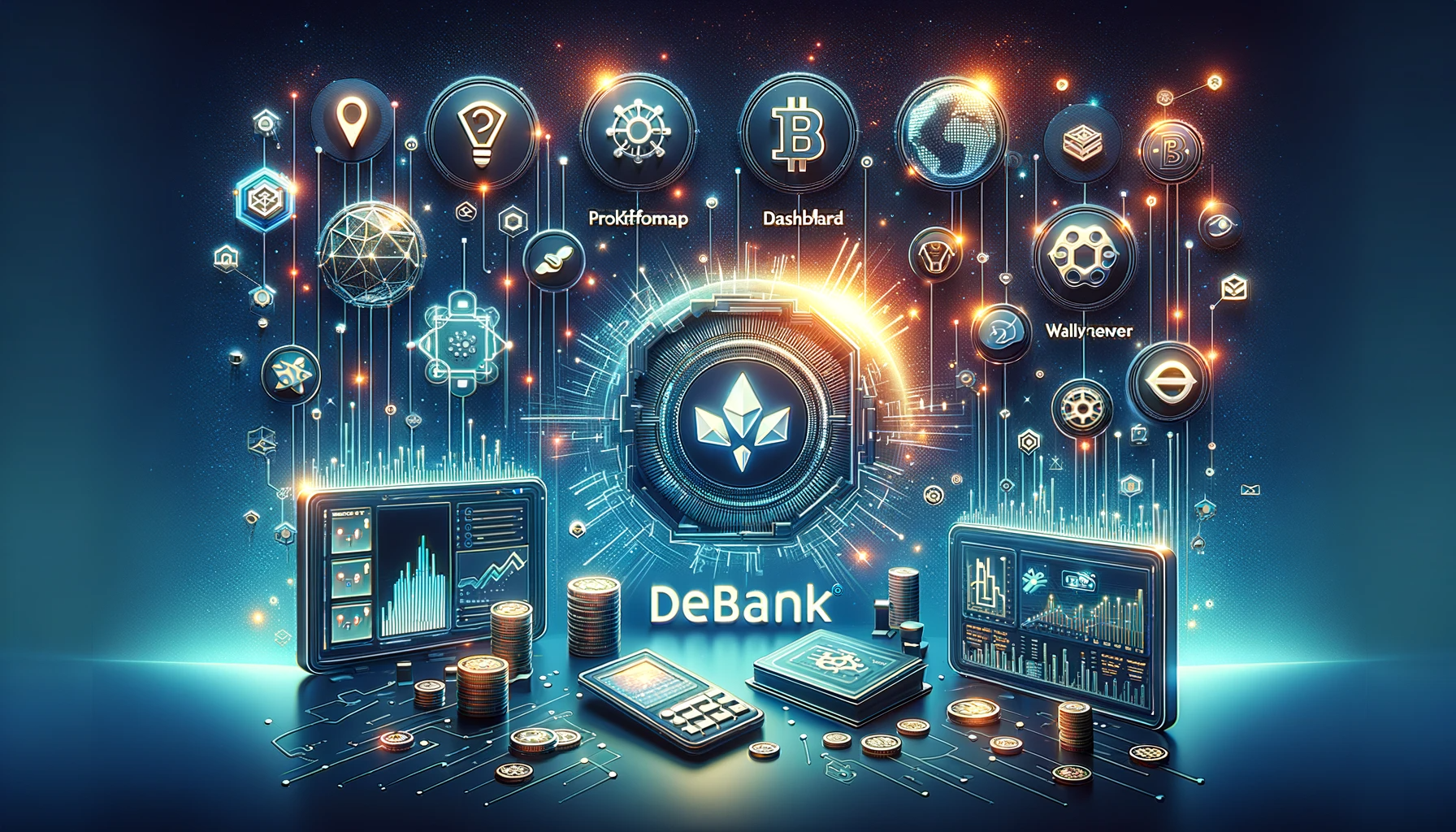DeBank is a platform that provides extensive services for tracking and managing decentralized finance (DeFi) and user assets on the blockchain. After DeBank, an asset monitoring company, introduced social networks like Hi and Stream, it announced the start of a testing period for its Layer2 network. From this, one can analyze its extensive product ecosystem.
- The Development History of DeBank
- DeBank Support
- Core Products of DeBank
- How DeBank Chain Works
- DeBank Competitiveness Overview
- Prospects and Challenges of DeBank
- Conclusion

The Development History of DeBank
DeBank was initially perceived as a tool for monitoring multi-chain DeFi portfolios or a social network. After five years of development, it has evolved into a comprehensive Web3 platform, offering a multitude of services: from social networks to wallets, data analysis, portfolio monitoring, and swapping functions. Recently, DeBank launched its own second-layer blockchain system, Debank Chain, highlighting its continuous expansion and diversification.
Throughout its development, DeBank has achieved several important milestones:
- Starting with the creation of a DeFi dashboard for portfolio tracking.
- Adding a Swap feature for direct participation in DeFi operations through the platform.
- Launching a Web3 social platform and Web3 ID in January 2022, giving users the ability to track the actions of major traders, NFT market trends, and friends' activities on the blockchain in real-time.
- In July 2022, Rabby, a browser wallet specially designed for DeFi users, was introduced.
- In October of the same year, the Web3 communication app Hi was presented.
- In August, the company announced the launch of DeBank Chain, a second-layer blockchain based on OP Stack, which is currently in the testing phase.
DeBank is available both through a web interface and on mobile platforms iOS and Android, with the Android version having already reached over 100,000 downloads.
DeBank Support
Currently, DeBank is supported by a team of 14 specialists, including its founders, who have significant experience in the Web2 domain.
Xu Yong previously held the position of CTO at an internet company, after which he founded his startup FellowPlus, specializing in the development of analytical tools. Tang Hongbo, before joining DeBank, worked as a software engineer at Adways Inc., and then became the head of R&D at DeBank. In December 2021, DeBank raised $25 million in investment, led by Sequoia Capital China, bringing the company's valuation to $200 million.
Core Products of DeBank
Asset Monitoring Dashboard
DeBank offers an asset monitoring dashboard that, once a user's chosen wallet is connected, displays the assets it contains, indicates the DeFi platforms where these assets are located, and shows changes in asset values. The homepage also features NFTs, Web3 badges, and messages posted on DeBank. Beyond tracking functions, the homepage provides the ability to add information to the user's profile not directly related to the blockchain, such as signatures and avatars, allowing other users to gain more information about accounts and follow them.
As part of this functionality, DeBank introduced two key indicators for analyzing wallet activity:
- Total Value of Followers (TVF), which reflects the cumulative value of assets owned by the user's subscribers.
- Trust, measured by the number of "trusts" (similar to likes) received for posts and comments on DeBank.
Platform Tools Panel
DeBank's data toolkit offers users the following possibilities:
- Social Web3 ranking: Ranks users based on a combination of their digital assets and the total number of TVF/subscribers. This mechanism allows for searching influential profiles with financial potential for subscription.
- Official profile rating: A separate classification for profiles created by projects and developers in the Web3 sphere, based on their TVF and number of subscribers.
- Web3 badges: DeBank awards badges to users who have achieved certain goals or participated in promotions (users monetize badges independently). For example, recipients of the $APE airdrop will be marked as APE Airdrop Hunter, facilitating the identification of certain user groups.
- Lists: Provides the ability to create customizable address lists, with the possibility to organize up to 5 lists containing up to 10 addresses each, for convenient categorization and monitoring.
- "Whale" monitoring: DeBank selects a group of addresses with large assets, allowing tracking of key transactions and movements in the network.
- Protocol analysis: Offers detailed analysis of internal blockchain protocols, ranking them by asset size. Users can filter protocols by network affiliation, type, and other parameters. When selecting a specific protocol, information about its users, the total value of locked assets, and other important indicators are available.
- NFT analytics: Provides access to current information about NFTs and their rankings, offering real-time data.
Web3 ID Product
Web3 ID is a product from DeBank, functioning similarly to ENS domain names. Users have the opportunity to select and register a unique identifier ranging from 4 to 15 characters, at a cost of $96.
To obtain a Web3 ID, one must first create an account on DeBank, with the registration process taking place on the specialized DeBank Layer2 page. It's important to note that DeBank Layer2 is not a separate blockchain but functions more as a contract for managing assets, including staking and withdrawal capabilities. Registration is available for blockchains such as Ethereum, Polygon, BNB Chain, Optimism, and Arbtrium, allowing users to choose the suitable network considering transaction fees.
The total assets placed in DeBank Layer2 currently exceed $4.1 million, of which $1.3 million was withdrawn, leaving $2.8 million in circulation. The approximate number of users who made deposits is about 80 thousand. Based on these figures, it can be concluded that the number of created Web3 IDs does not exceed 80 thousand, considering that funds for creating the identifier are deducted from the deposited assets.
Rabby Wallet
Rabby Wallet is an open-source multi-chain cryptocurrency wallet created by the Debank team. This wallet is aimed at serving DeFi users, offering risk scanning features before transactions for secure financial protection. It also shows the expected changes in balance before confirming operations.
In April of this year, Rabby Wallet expanded its capabilities by integrating with Scam Sniffer—an instrument for blocking fraudulent URLs, and adding three new security features: site trust evaluation, popularity analysis, and phishing resource detection. These tools allow users to assess the reliability of websites by checking their reputation on DApp platforms, as well as analyzing their traffic and engagement level, and determining whether they are phishing targets. Currently, Rabby Wallet is compatible with 95 blockchains, and its Chrome browser extension has been installed more than 100,000 times.
DeBank Stream
DeBank Stream is a content hosting platform operating similarly to X (formerly Twitter), where content creators earn rewards for attracting audience attention and time. Earnings on the platform depend on content popularity, including the number of subscribers, views, comments, and reposts, as well as the author's asset value.
Traditional content publishing methods are supplemented with unique features:
- Creating polls with the option to select questions and answers, setting criteria for respondents such as asset size, TVF, age, and number of subscribers.
- Organizing prize draws with specified conditions, amount, number of prizes, and participant pool.
DeBank Stream evaluates users' contributions to the platform's activities, creating a reward pool for each published article. Over 3 days, users can contribute assets to the pool, and each user's contribution is considered when distributing rewards. After this period, rewards are paid out. If the pool collects more funds than were estimated for the post's content, the surplus goes to the author, functioning as a reward system for valuable contributions. Thus, DeBank Stream converts the time spent on the platform, interactivity, commenting, and reposting into tangible values for its users.
DeBank Hi
DeBank Hi is a Web3 communication application that allows users to interact with each other through text, images, and emojis, as illustrated in the image provided. This application differs from traditional communication methods by incorporating a concept similar to market trading mechanisms to simplify communication and prevent unwanted messages.
The main concept of DeBank Hi involves treating users' attention as a valuable resource and forming a market to determine its value. When receiving messages through this application, users essentially offer their attention in the form of NFTs (Attention NFTs). The sender must specify the amount they are willing to pay for the recipient's attention. The recipient, upon viewing the message, can agree to the proposed price and make the transaction, thereby commercializing their attention.

How DeBank Chain Works
DeBank Chain is a second-level solution developed by DeBank based on the Optimism OP Stack technology. This solution includes numerous improvements, such as a modernized consensus system, which have made it possible to significantly reduce gas expenses for data storage operations by 100 to 400 times compared to first-level blockchains. Additionally, DeBank Chain has implemented the Abstract Accounts (AA) system, simplifying interactions with smart contract accounts while providing a web2-like user experience and full compatibility with the existing EVM standard.
Users are given the option to add the DeBank test network to MetaMask for conducting transactions. Below is a table with the main network parameters for setup:
| Parameter | Value |
|---|---|
| Network Name | DeBank Testnet |
| Chain ID | 2021398 |
| Currency Symbol | USD (test) |
| Explorer URL | https://explorer.testnet.debank.com |
| RPC URL | [Not Provided] |
The above information can be used to integrate the custom network into MetaMask.
At the time of providing this information, the DeBank test network has registered 56 thousand wallets, which have made a total of 3.167 million transactions, indicating high activity and interest from the community.
DeBank Competitiveness Overview
Although DeBank is a multifunctional platform, it has no direct analogs, especially in terms of products like Stream and Hi, as well as the DeBank Chain blockchain focused on social assets. However, three competitors offering similar services in various segments were selected for analysis.
Social Applications
For comparison with DeBank's social applications Hi and Stream, we selected Friend.Tech. This choice is due to the fact that Friend.Tech, like DeBank, offers paid services. Friend.Tech is a social DApp built on the Base ecosystem, allowing users to buy and sell "shares" of other users for ETH. Shareholders of KOLs (Key Opinion Leaders) can communicate directly with them. This enables the buying and selling of Twitter account shares, and owning KOL shares grants access to private chats.
Unlike DeBank, Friend.Tech allows users to monetize their influence gained in other social networks, such as Twitter, whereas in DeBank one has to start from scratch. A different understanding of social interactions suggests that DeBank's success requires long-term efforts and attracting valuable users to create content on the platform.
Social Infrastructure
As for social infrastructure, DeBank itself acts as the blockchain. Let's compare it to Lens Protocol. DeBank's advantage lies in its Account Abstraction (AA) technology, which simplifies the use of smart contract functions. In contrast, Lens Protocol serves as a tool for social platform developers, offering them ready-made modules to create new products. Lens Protocol simplifies the development process, whereas DeBank gives developers more freedom to create their projects, including Web3 ID and Data API. In terms of revenue, Lens Protocol has yet to establish a clear business model, whereas DeBank has stable income sources through network and API fees. Despite this, Lens Protocol has already attracted over 100,000 users to applications built on it, while DeBank is still testing its capabilities without clear use cases.
Asset Tracking Dashboards
In the asset tracking sphere, where DeBank operates, there is a counterpart called Zapper. Zapper also offers asset tracking, analytics, and address monitoring. Unlike DeBank, Zapper focuses on displaying on-chain activity, allowing users to observe their subscribers' activity, popular themes and actions, and perform operations directly within the app.
As of now, Zapper has only achieved 10,000 downloads, significantly less than DeBank's over 100,000 downloads. Zapper is actively developing the depth of its product, especially in data aspects and activity monitoring, where DeBank has yet to offer such a comprehensive approach. However, DeBank's multifunctionality contributes to a higher level of user retention due to the ability to use various services within one platform.

Prospects and Challenges of DeBank
DeBank's experience in creating and launching products demonstrates the high competence of their team. They regularly introduce new products related to their core asset management and wallet services, gradually forming a multifunctional ecosystem. In this ecosystem, users can interact both within and outside the blockchain, using analytical and social tools, which most dApps and aggregators do not offer at the moment.
With the development of DeBank Chain, it is expected that applications based on it will be actively integrated into the ecosystem, attracting more users. This will enhance the reliability and value of the platform's data and ratings, attracting new projects and influencers to create content. Ultimately, this contributes to the growth and strengthening of the ecosystem through an interconnected cycle of development and implementation.
However, despite its innovative approach and development, DeBank faces several challenges:
- Intense Competition
In both the social sphere and the DeFi area, competition is intensifying. Competitors try either to copy DeBank's successful products or to develop unique solutions in their ecosystems.
- Limited Multi-Chain Support
Currently, DeBank's second-level staking is integrated with only five blockchains, which may inconvenience users outside these networks.
- Security Issues
On October 11, 2022, a security incident occurred, resulting in the loss of user assets. This highlights the need for additional efforts to protect user funds.
- High Entry Threshold
To activate social functions, a Web3 ID is required, costing $96, which may be unacceptable for some users. Moreover, the introduction of paid social interactions creates an additional barrier for ordinary users to participate in the ecosystem.
Conclusion
In the five years of its existence, DeBank has transformed from a basic tool for tracking DeFi portfolios into a large-scale Web3 platform offering a wide range of services: from social interactions and wallet management to data analytics. The company has also introduced its own second-level blockchain called Debank Chain, demonstrating its commitment to innovation. DeBank strives to create an efficient ecosystem that facilitates activity both within blockchain networks and beyond. Ahead of DeBank lie challenges to overcome, including fierce competition, multi-chain support limitations, security issues, and barriers to user engagement. Nonetheless, through continuous innovations and improvements, DeBank asserts itself as a significant player in the Web3 world.




